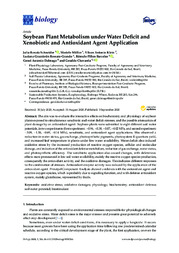Soybean plant metabolism under water deficit and xenobiotic and antioxidant agent application.
Soybean plant metabolism under water deficit and xenobiotic and antioxidant agent application.
Author(s): SCHNEIDER, J. R.; MÜLLER, M.; KLEIN, V. A.; ROSSATO-GRANDO, L. G.; BARCELOS, R. P.; DALMAGO, G. A.; CHAVARRIA, G.
Summary: The aim was to evaluate the interactive eects on biochemistry and physiology of soybean plants exposed to simultaneous xenobiotic and water deficit stresses, and the possible attenuation of plant damage by an antioxidant agent. Soybean plants were submitted to eight different soil water potentials, in two experiments (first experiment: 0.96, 0.38, 0.07, 0.02MPa, and second experiment: 3.09, 1.38, 0.69, 0.14 MPa), xenobiotic, and antioxidant agent applications. Was observed a reduction in water status, gas exchange, photosynthetic pigments, photosystem II quantum yield, and increased leaf temperature in plants under low water availability. Water deficit also induced oxidative stress by the increased production of reactive oxygen species, cellular and molecular damage, and induction of the antioxidant defense metabolism, reduction of gas exchange, water status, and photosynthetic eciency. The xenobiotic application also caused changes, with deleterious eects more pronounced in low soil water availability, mainly the reactive oxygen species production, consequently the antioxidant activity, and the oxidative damages. This indicates dierent responses to the combination of stresses. Antioxidant enzyme activity was reduced by the application of the antioxidant agent. Principal Component Analysis showed a relation with the antioxidant agent and reactive oxygen species, which is probably due to signaling function, and with defense antioxidant system, mainly glutathione, represented by thiols. Keywords: oxidative stress; oxidative damages; physiology; biochemistry; antioxidant defense; soil water potential; biostimulant
Publication year: 2020
Types of publication: Journal article
Unit: Embrapa Wheat
Observation
Some of Embrapa's publications are published as ePub files. To read them, use or download one of the following free software options to your computer or mobile device. Android: Google Play Books; IOS: iBooks; Windows and Linux: Calibre.
Access other publications
Access the Agricultural Research Database (BDPA) to consult Embrapa's full library collection and records.
Visit Embrapa Bookstore to purchase books and other publications sold by Embrapa.

